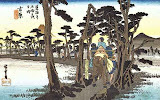Traditional Arts and Crafts-Painting
Painting
In Japan, painting is broadly classified into two types, Japanese style and Western style. Art classes at ordinary schools are limited to Western styles such as oil- and water-color painting instruction in Japanese-style painting being concerned only with appreciation. Because of this, the majority of today’s artists paint in Western styles.
However Japanese-style paintings are more appropriate for the traditional Japanese house, and thus have many devotees. Japanese paintings are done on silk or Japanese paper with a brush, using sumi and mineral colors (pulverized lapis, malachite, ocher etc.) Pigments have to be dissolved in a solution of glue for use, and this requires a fair degree of practise and technique.
 The Japanese style or painting was originally introduced, together with Buddhism, from Chine. The suiboku (black and white drawings of wash and line) of that time were characterized by an allusive of expression that, based on lines and shades of sumi, was simple and unsophisticated. The Chinese artistic influence continued to be felt, and modern Western naturalism has also provided a stimulus, so that now the main emphasis is on colored pictures.
The Japanese style or painting was originally introduced, together with Buddhism, from Chine. The suiboku (black and white drawings of wash and line) of that time were characterized by an allusive of expression that, based on lines and shades of sumi, was simple and unsophisticated. The Chinese artistic influence continued to be felt, and modern Western naturalism has also provided a stimulus, so that now the main emphasis is on colored pictures.
The ukiyoe paintings of the Edo period are very popular even today. A form of genre picture, some were painted by hand, but it is as prints that they became widely known. the most common subjects were scenes from the theater, and portraits of famous beauties, actors and sumo wrestlers, but historical themes, landscapes, birds and flowers were also depicted.
The development by Harunobu Suzuki of muiti-color printing in the mid-eighteenth century gave rise to the golden age of color prints. One type or picture or beautiful women that had a circulation abroad was the pornographic shunga, but this style accounts for only a small fraction of the ukiyoe genre.
It is said that the influence of the ukiyoe art of drawing on the French impressionists resulted in development of the new techniques of realism
【日本語訳】
絵画
現代日本の絵画は、洋画と日本画に大別される。一般の学校教育では絵画の制作は油絵・水彩画などの洋画に限られ、日本画は鑑賞されるのみである。そのため画家の数、制作点数などでは洋画の方が多い。しかし日本画は、日本家屋に飾る絵としてふさわしく、尾の愛好者も多い。日本画は絹地または和紙の上に毛筆で、墨と岩絵具(群青・緑青・黄土などの鉱物を砕いたもの)を用いて画く。絵具は、膠の溶液にといて画くもので、かなりの習練と技術を要する。
日本画は、当初仏教とともに中国から伝わり、線と墨の濃淡を基にし簡素・素朴で暗示的な表現法を特徴とする水墨画であった。その後、更に中国の影響を受け、近代以後は西洋の自然主義にも刺激され、現代では彩色画が中心になっている。江戸時代の絵画で、現在でも広く鑑賞されているものに浮世絵がある。民衆的風俗画の一様式で肉筆画も行なわれたが、特に版画として普及した。その画題は、芝居の情景・美女・役者・力士の似顔絵を主とし、歴史画や風景・花鳥に及ぶ。
18世紀中頃に、多色刷版画が鈴木春信により創始され黄金期を迎えた。浮世絵の代表的なものとして春画が外国で流布したことがあるが、これは浮世絵のほんの一部でしがない。浮世絵の画法がフランス印象派に伝えられ、新しい写実技法が展開したといわれている。
注)国語辞典で浮世絵の項をみると、第2番目の意味として春画のこととなっている。外国では浮世絵即春画と考えられることがあるので、表現には注意を要する。
